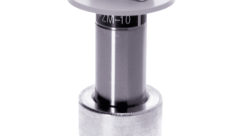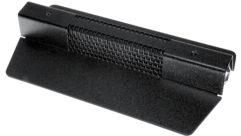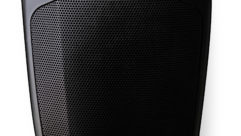

Designed especially for stage pickup, the AKG PCC160 boundary mic has a three-position bass tilt switch to adjust low end response. Its PCC (Phase Coherent Cardioid) technology keeps any phase cancellation out of the audible frequency range and the supercardioid polar pattern reduces room noise pickup. The 12-48V phantom power operates the mic and its three-pin mini XLR connector is well hidden on the case. It is supplied with a 15ft. XLR to mini XLR cable and a carrying pouch. AKG’s DMM8 U automatic mixer can be cascaded for up to 10 units, expanding each eight-input mixer to a group of 80 channels. Each unit also has two stereo audio outputs, USB, filters, compressor/limiter, ducking, and routing. The LAN port enables control by third-party control systems from anywhere online. The ULD model features a DANTE interface with each input including a direct out.
Also offering solutions in both categories, Audio-Technica provides exceptional sound pickup with the ES963 three element multidirectional boundary mic. The elements can be individually powered and used to provide a choice of polar patterns to suit the room. Two of the elements can be reoriented using small levers on the base. The unit also features UniGuard RFI-shielding technology to allow a clean, interference free signal. Its new teammate, the ATDM-0604 Digital SmartMixer, introduced at InfoComm this year, is a six-channel unit that can operate in gate or gain sharing mode to handle mixing in meetings, conferences, courtrooms, and similar environments. The mixer has a flexible web remote interface along with LEDs on the front to let the user set input/output gain levels; store and recall presets, and adjust many other parameters.


The ADX60 boundary mic from Audix is designed with a hemicardioid polar pattern to provide sensitive coverage of a designated area and has a 25ft. cable and phantom power adapter included. The steel mesh grill and space-saving mini-XLR connector provide flexible placement and tough protection. The mic has 50Hz to 8kHz frequency response, maximum SPL ≥130dB, signal to noise ratio above 65dB and operates on 9V to 52V from its APS910 power supply. The black diecast zinc case blends well into any conference room or theater stage and it incorporates a rubber base to dampen vibrations. An optional accessory, the APS911 battery operated phantom power adapter has an on/off switch and bass roll-off.

A dynamic duo in mics and mixing, the beyerdynamic Quinta TB digital wireless boundary mic and the Quinta CU control unit can provide an automatic mixing setup for even the most complex professional conferencing applications. The Quinta TB features Sequence Spread Spectrum (DSSS) operation for security and clean signal in three frequency bands. Powered by integrated NiMH batteries, the mic can send its battery charging status to the control unit. In conference mode, it can operate in manual, override, push-to-talk, or push-to-mute mode. In microphone mode, it has on/off, push-to-mute, and global mute modes. The Quinta CU can control up to 150 wireless microphones and there is constant status inquiry, monitoring, or control via the microphone data connection. Security is assured through 128-bit encryption and a 24-bit PIN-code. The integrated Web server allows configuring the control unit with a smartphone, tablet PC, or PC via USB, LAN, or WLAN.

CAD Audio has a very versatile instrument in the 220VP button style boundary mic with its continuously variable polar pattern. Well-shielded from RFI sources, the 220VP includes an 80Hz 12dB/octave high-pass filter to minimize room rumble and mechanical noise. It can be mounted in surfaces up to 3in. thick and there is a standard 3-pin XLRM-type connector recessed into the body. A selection between five patterns can be set with a small dial on the mic body and the polar pattern is continuously variable with the addition of the VPC-1 remote Variable Pattern Control Box.

The Delta Mic from Clearone is made for conferencing with its three unidirectional microphones mounted in a single housing for a 360-degree pickup pattern which minimizes background rooms noise. At the end of the 25ft. shielded cable are three male XLR connectors. The mic has a frequency response of 30Hz to 20kHz and a maximum input sound level of 130dB. For big conferencing environments, the Converge SR1212A is a 12×12 automatic digital mixer with four 35W power amplifiers each with advanced DSP. Equipped with Ethernet and USB connections, the mixer features DARE (Dynamic Automatic Resonance Elimination) for control of feedback along with an event scheduler and diagnostic console. The configuration software includes drag and drop AV and channel objects and selectable views. The flexible unit allows 10 mic gating groups, presets, and up to 255 macros.


For an extremely small and unobtrusive conference microphone solution, Clockaudio has the ARM 102-RF digital motorized condenser microphone that, with the touch of a button, can be retracted into a table leaving only 3mm above the flat surface. Operating on from 9V to 45V phantom power, the ARM 102-RF is available in black or nickel finish and its solid brass construction is tough. The mic has a cardioid polar pattern, balanced output, and a built-in RF filtering. For handsoff mic mixing, the MR88 offers eight inputs and a front panel LCD for settings and adjustments. Also on the front are an output level meter and auto-selected channel indicator. The settings can also be made from a PC on the RS232 port and each channel has a recording output.


The DPA d:screet BLM4060 boundary layer microphone has an omnidirectional pickup pattern from its central condenser element, held in place by a rubber disc at the center of its stainless steel base. This arrangement highlights speech intelligibility at a distance and blends into any conference table design. It comes with a 10ft. black cable and its cable adapter system allows the mic to attach to virtually any type of input connector and a wide range of wireless systems. The BLM 4060 delivers 20Hz to 20kHz frequency response and handles a maximum dynamic range of 100dB. The mic operates on 5VDC-50VDC power through the DPA adapter for wireless systems or 48V phantom power ±4V with DAD6001- BC XLR adapter.
Pioneer of automixing, Dan Dugan Sound Design includes among its array of products the Model N with 64 channels of processing, and its channels can be grouped into three separate automatic mixers. The Model N is PoE capable and it is equipped with primary and secondary DANTE network connectors. Remote control can be operated from the Dugan Control Panel for Java which is included, and from the Dugan Control Panel for iPad, sold separately. In the default con figuration , one pair of ADAT connectors is used for the I/O of eight audio channels. The second pair is used to link Dugan units. The LINK connectors can be repurposed to provide eight additional ADAT I/O channels, for a total of 16. Up to eight of the units can be linked in any combination to form an expanded system.

Its extremely low profile makes the Earthworks CTB30 high-definition boundary microphone a very unobtrusive choice for fixed or temporary conferencing sound systems. The TableComm Series Microphone’s True Semisphere polar response provides good frequency response all the way around the unit’s table position from 60Hz to 30kHz. Shielded from cell phones and other RF devices, the mic also has filtering for table thumping and HVAC noise. Available in black, white, silver, or Nextel dark-black finish, the mic comes with a 10ft. low-profile cable with XLR-3M attached and is designed to exit from the side or bottom of the microphone. The XLR can be removed for running the cable through tight spaces. For secure and more permanent mounting, there are two 6-32 screw holes and a keyhole on the bottom of the microphone.

Lectrosonics provides its Aspen Series mixers with the capability to handle conferencing environments requiring small to very large and complex solutions. The SPN812 offers eight mic/line inputs and 12 outputs in a single or two-rack unit, which is TCP/ IP Ethernet addressable and multi-point controllable by third-party devices. Control can also be done through USB, RS-232, and logic I/O ports using the large command library. The SPN812 features automatic master/slave detection, unlimited input expansion by stacking units, ultra-low noise input preamps and its single Ethernet port carries data, audio, and control signals. Its full crosspoint matrix with 48 outputs adds substantial flexibility. After processing, the signal can be assigned to any one or more crosspoints in the matrix for mixing and forward propagation to the master unit.

The Revolabs Elite Wired Microphones with local and external Control come in a variety of formats and colors and they add enhanced mute functionality to the company’s wired microphone offering. The Elite Wired line is a five-wire microphone that augments its three-wire predecessor, offering local control of push-to-talk, push-to-mute, and mute toggle control, as well as integration with DSP systems for programmable remote mute control. The five-wire version also incorporates an LED for visual indication of the mute state, so users always know whether the mics are live or muted.

Sennheiser designed the MEB 102 omnidirectional condenser boundary layer microphone for fixed installation in conference tables or ceiling tiles and its -L variant features a bi-color (red/green) LED ring for status indication through a five-pin XLR connection. Available in black, white, and Nextel gray, the mic provides a frequency response of 40 Hz to 20 kHz, an omnidirectional polar pattern and a dynamic range of 104dB. The unit runs on 48V phantom power with a current of 3mA and it can be mounted into a 10mm to 65mm surface thickness so that it extends only 12mm out from the table or ceiling surface. The MEB 104 is the cardioid variant with the same mounting parameters as the MEB 102.

The MX690 Microflex wireless boundary microphone from Shure eliminates cables and mounting holes while displaying its status with a bi-color LED. Its IR link to an SLX receiver provides immediate frequency sync and the cardioid condenser unit’s logic output allows remote LED and programmable mute control. The mic operates on two AA batteries and it includes a battery level indicator. The system can operate in any of five bands extending from 470.125MHz to 661.8MHz and its Commshield technology offers protection from sources of RF interference. Also from Shure is the SCM820 8-channel digital Intellimix automatic mixer. With dynamic channel gating and attenuation, the background noise is minimized while its Noise Adaptive Threshold and Number of Open Microphones Attenuation (NOMA) features work to provide seamless operation for conferences and meetings. The mixer has A and B outputs at line or mic level and it has front and back aux inputs for media playback.


For a powerful mixer to take to the field, Sound Devices offers the 633 with its 10-track recording capability, flexible inputs and outputs, and two automixing options. Sound Devices MixAssist and Dugan automixing take the load off of the sound crew. The unit can operate in a number of power modes including external DC, 7.2 V L-type lithium ion cells, or six internal AA batteries. If all of those are depleted, the 633 goes into PowerSafe to make sure all files are saved. When operated with the required WM-Connect Bluetooth Smart USB accessory, the Wingman wireless remote control option provides clear views of metering and timecode display on Android and iOS mobile devices.

TOA Electronics offers a very small and unobtrusive line of conferencing sound devices in their EM-Series Presentation Microphones. The EM-700 has a very low profile and its hemispherical polar pattern allows even sound coverage around the table. Ambient noise pickup is minimized using its low-cut filter switch on the unit’s base which rolls off response by 12dB per octave below 100Hz. The mic operates on 9V to 52V with a frequency response of 30Hz to 20kHz and has a 3-pin XLR connector. The body is diecast aluminum with a matte black finish to blend with any room décor.

The solution for ease of operation and user freedom has been introduced by Yamaha Commercial Audio in the TF Series of mixing consoles with their TouchFlow user interface. Recallable D-PRE preamplifiers assure a good starting point for quality sound and software applications integrate seamlessly with the entire system. The control face integrates extensive touchpanel creativity with the right hardware knobs and buttons for quick adjustments. The new GainFinder feature facilitates optimum gain setup for individual input signals and the system provides more than 100 presets that range from vocals to drum sets. The scene memory features banks A and B, each capable of holding up to 100 scenes. A display panel above each channel fader shows the assigned channel name or ID, the port name, and the current fader setting. An assignable color bar makes navigating the board very easy.










